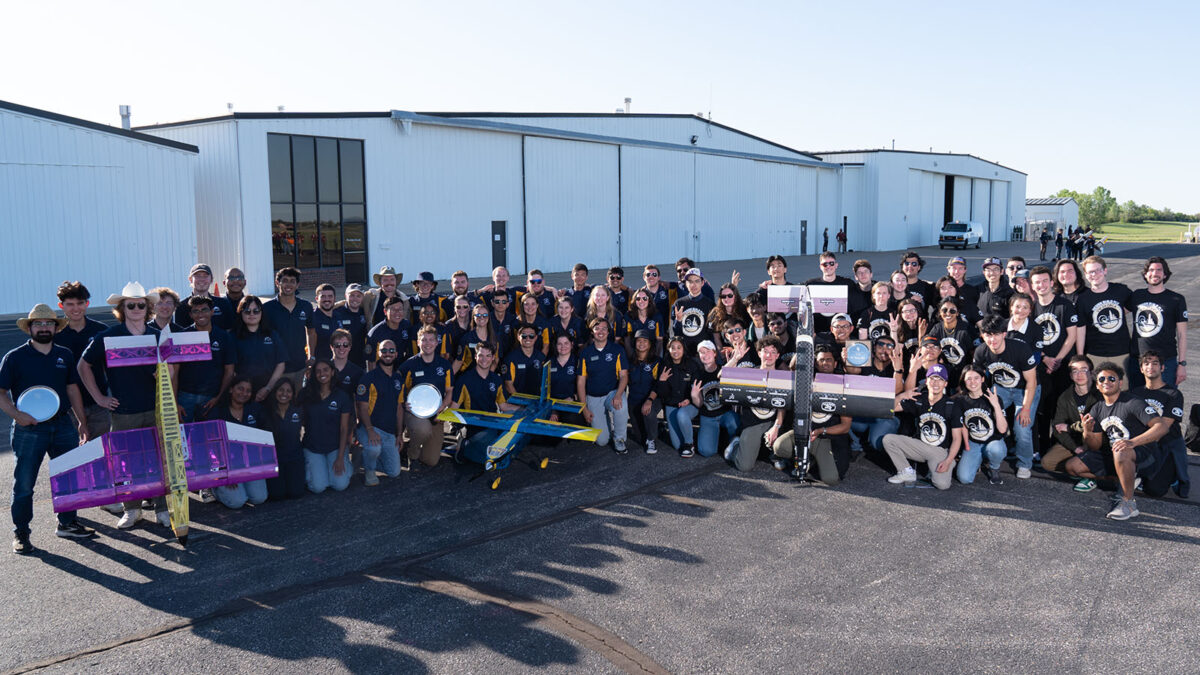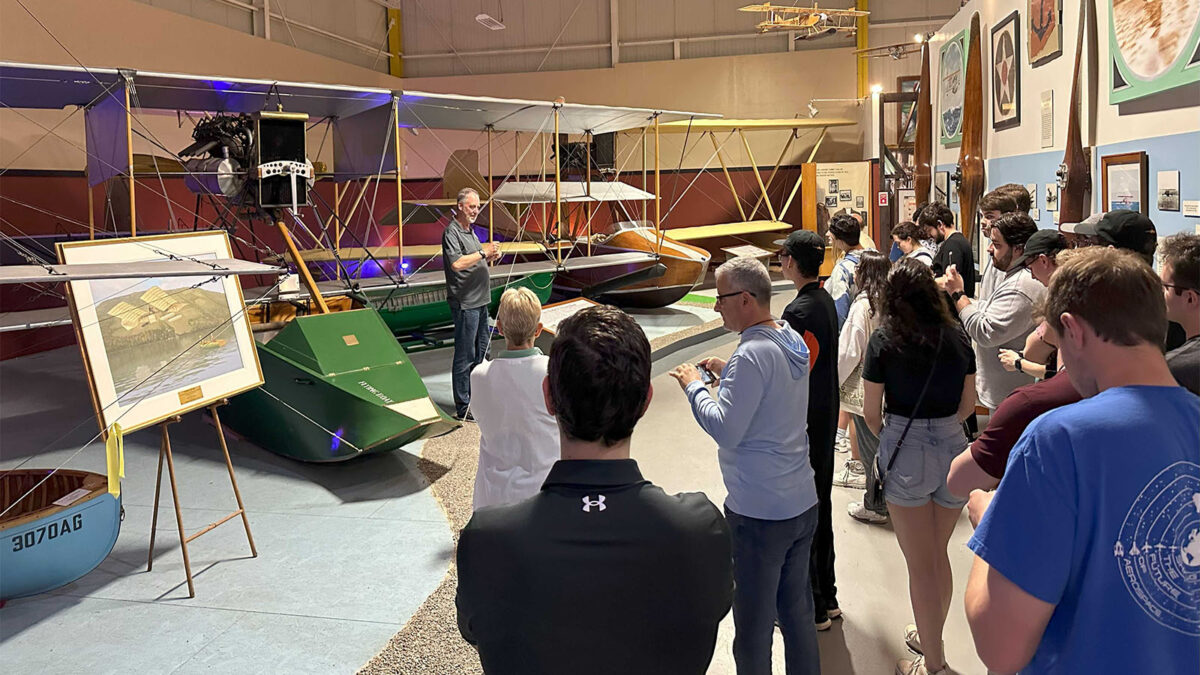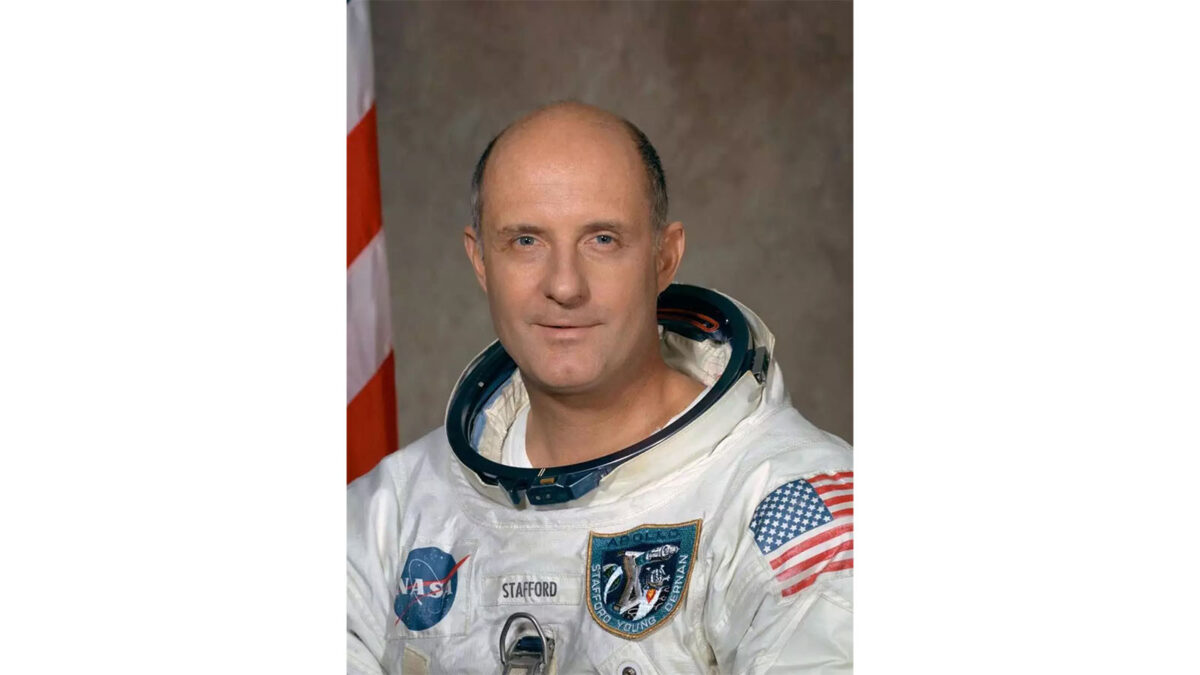- 2024 AIAA Awards Gala Held in May
- Making an Impact: 2024 DBF Attracted Record Numbers
- AIAA Supports PEGASUS Student Conference in Spain
- Niagara Frontier Section Hosts Lecture at Glenn Curtiss Museum
- Nominations for AIAA Election Are Being Accepted Through 14 July 2024
- AIAA Fellow Fester Died in May 2023
- AIAA Fellow Stafford Died in March 2024
- AIAA Fellow Mullin Died in April 2024
Bulletin
AIAA Program 2024 AIAA Awards Gala Held in May

AIAA presented its premier awards at the AIAA Awards Gala, 15 May, at The John F. Kennedy Center for the Performing Arts in Washington, DC. The Class of 2024 AIAA Fellows and AIAA Honorary Fellows also were recognized. During the event Immediate Past President Laura McGill passed the ceremonial gavel to Dan Hastings, AIAA President (2024-2026). View all the photos in the AIAA Gala Flickr album.
AIAA Foundation Making an Impact: 2024 DBF Attracted Record Numbers

The 2024 Design/Build/Fly (DBF) competition had the largest-ever fly-off participation, with more than 1,000 students on 93 university teams attending onsite. The fly-off, hosted by AIAA Corporate Member Textron Aviation in Wichita, KS, took place 18–21 April. Teams from 12 countries and 32 U.S. states participated in the full DBF Competition, including submitting design reports and attending the fly-off.
This year’s flight objective was to design, build, and test a remotely operated radio control airplane for urban air mobility. The airplane needed to be able to conduct a delivery flight, a medical transport flight, and an urban taxi flight. Teams also conducted a ground mission demonstrating how quickly they could change their aircraft configuration from delivery to medical transport to urban air taxi.
The 2024 DBF winners are:
• 1st Place ($3,000): Embry-Riddle Aeronautical University,
Daytona Beach
• 2nd Place ($2,000): Georgia Institute of Technology
• 3rd lace ($1,500): University of Washington, Seattle
• Best Design Report ($100): University of Southern California
The success of DBF is due to the efforts of many volunteers from Textron Aviation; Raytheon, an RTX Business; and the AIAA sponsoring Technical Committees: Applied Aerodynamics, Aircraft Design, Flight Test, and Design Engineering. The 2025 DBF competition will be hosted by Raytheon, an RTX Business, in Tucson, AZ, in April 2025. For more information on how your organization can engage with and sponsor this event, please contact Alexandra D’Imperio, alexandrad@aiaa.org.
AIAA Student Programs AIAA Supports PEGASUS Student Conference in Spain

The 20th PEGASUS Student Conference took place 26-27 April, at the Universidad Politècnica de Catalunya in Terrassa, Spain. This conference gives graduate students the opportunity to present their technical work. The first-, second-, and third-place winners receive cash prizes from AIAA, and the first-place winner will compete at the International Student Conference, 6–10 January 2025, Orlando, FL, with the other first-place Regional Student Conference winners.
1st Place –”Optimization Strategies for System Architecting Problems,” Santiago Valencia Ibanez, TU Delft
2nd Place – “Experimental study of flame/wall interaction for hydrogen/air mixtures,” Malik Suryadeb, ENSMA
3rd Place (tie) – “Joint analysis of Europa Clipper and JUICE missions to contain the Galilean moons’ ephemerides,” Vittorio Gargiulo, Sapienza – Università di Roma
3rd Place (tie) – “Impact of non-ideal fluid modeling on droplet vaporization for aerospace fuels,” Edoardo Forti, Sapienza – Università di Roma
Section News Niagara Frontier Section Hosts Lecture at Glenn Curtiss Museum

On 28 April, the AIAA Niagara Frontier Section (NFS) held an event at the Glenn Curtiss Museum. Walter Gordon, AIAA Distinguished Speaker as well as NFS chair, discussed the “Curtiss Jenny: The Aircraft that Created the Army Air Service.” He examined the evolution of Curtiss aircraft from the Model D pusher, with its clear resemblance to the original Wright Flyer, to the Jenny that accompanied the Pershing Expedition to Mexico in just four short years. The talk was attended by about 30 students and faculty from the Rochester Institute of Technology and the University at Buffalo.
AIAA Announcements Nominations for AIAA Election Are Being Accepted Through 14 July 2024
The Institute is currently seeking nominations for the following positions.
AIAA President-Elect Nominations
The AIAA Executive Nominating Committee (ENC) will compile a list of potential nominees for the position of AIAA President-Elect. This list will include nominees who will be selected to go to the next step of competency review (see competencies listed below in At-Large Nominations section) and interview held by the nominating committee. The ENC will select specific candidates for the position who will be voted on by the AIAA membership. The final slate of candidates will be publicized by December 2024 for the election that will be held January 2025.
To nominate an AIAA member in good standing for AIAA President-Elect, please submit the nominee’s bio and/or CV, history of AIAA activities and/or engagement with other professional societies, and a statement from the nominee of willingness and ability to serve if elected.
AIAA Board of Trustees – Members–At-Large Nominations
The AIAA Executive Nominating Committee (ENC) will compile a list of potential nominees for the Board of Trustees – Members–At-Large. The list will include nominees who will be selected to go to the next step of competency review and interview held by the nominating committee. The ENC will select specific candidates for the Institute’s Board of Trustees – Members–At-Large in November 2024. The Board of Trustees – Members–At-Large will be elected by the Council of Directors in January 2025 and announced soon thereafter.
The skills and competencies being sought for the President-Elect and the Board of Trustees are:
Vision: Persons who have the ability to understand present states, clearly define what they should be in the future, and identify steps to achieve those ends.
Diverse Business Acumen: Persons who have the knowledge and understanding of the financial, accounting, marketing, communications, human resources, policy, and operational functions of an organization as well as the ability to make good judgments and quick decisions.
Domestic and International Aerospace Knowledge and Experience: Board membership reflects: a) the breadth of the various major sectors of aerospace both domestic and international; b) all levels of technology and systems development from basic research through all technology readiness levels to product development and deployment; and c) from different disciplines within aerospace.
Leadership/Strategy/Execution: Persons who have the ability to create a shared vision, obtain participation and buy-in, and achieve successful results.
AIAA Leadership and Participation: Board membership reflects experience in successful participation in a wide variety of leadership positions within AIAA, as well as knowledge of the governance model.
Experience in Adjacent Aerospace Areas: As the Institute broadens its reach beyond the traditional “Breguet Equation” disciplines, Board members who have experience and strategic perspectives in these adjacent areas will broaden the Board’s view on new and emerging areas.
Young Member Knowledge and Experience: As the Institute evolves, it is important that Board members have knowledge and understanding of issues relevant to young members in the aerospace industry.
Experience with Organizational Growth: Persons with experience in significantly growing organizations will serve as a resource to the Board as the Institute seeks to grow.
Experience with Change or Transition Management: Board members with prior experience in organizational change or transition will serve as a vital resource to the Board as it seeks to execute its role.
Demographic Diversity: In addition to reflecting the membership’s diversity in the industry and volunteer involvement, it is important that the new Board membership be seen as reflecting demographic diversity (e.g., gender, ethnicity, age, etc.) as well.
AIAA members may nominate qualified individuals for the AIAA Board of Trustees – Member–At-Large positions by submitting a nomination package of not more than three pages consisting of:
• Nominee’s Bio and/or CV and history of AIAA activities and/or engagement with other professional societies
• Statement from the nominee addressing how they meet the sought competencies
• Statement from the nominee of willingness and ability to serve if elected
AIAA Council of Directors Nominations
The AIAA Council of Directors Nominating Committee (CNC) will compile a list of potential nominees for the open Director positions on the AIAA Council of Directors. This list will include nominees who will be selected to go to the next step of competency review held by the nominating committee. The nominating committee will select specific candidates for the open Director positions who will be voted on by the AIAA membership. The final slate of candidates will be publicized by December 2024 for the election that will be held January 2025.
Nominations are being accepted for Regional Directors, Integration and Outreach Group Directors, and Technical Group Directors for the term May 2025–May 2028. AIAA members may self-nominate or nominate members qualified for the open position.
Regions coordinate the activities of geographically-related sections to facilitate cooperative efforts between the various geographical areas. A Regional Director shall lead each region. Nominations are being accepted for:
• Region IV – South Central, Director
• Region V – Mid-West, Director
For more information on AIAA regions and sections, visit aiaa.org/get-involved/regions-sections.
Integration and Outreach Groups coordinate the activities of related Integration and Outreach Committees to facilitate cooperative efforts between the various professional areas. Nominations are being accepted for:
• Aerospace Outreach Group, Director
• Integration Group, Director
• Young Professionals Group, Director-Elect
For more information on AIAA integration and outreach, visit aiaa.org/get-involved/committees-groups/Integration-and-Outreach-Division-Committees.
Technical Groups coordinate the activities of related technical committees to facilitate cooperative efforts between the various technical disciplines. Nominations are being accepted for:
• Information Systems Group, Director
• Propulsion & Energy Group, Director
For more information on AIAA technical activities, visit aiaa.org/get-involved/committees-groups/technical-committees.
AIAA Integration and Outreach Group Division Chief Nominations
AIAA Integration and Outreach Division (IOD) is the heart and muscle of AIAA’s programmatic and societal activities. These groups cover all programmatic and societal interests of the Institute. Work across technical disciplines to forward innovation in our industry by joining an Integration and Outreach Group.
The Chief of the IOD will lead the division and shall be elected by simple majority of the votes cast by the IOD Directors and the Division committees. The Chief will not be a current IOD Director; however, the Chief must have served as an IOD Director in the past. The term of the Chief shall be three years and there shall be a limit of the Chief serving one consecutive term.
A full listing of Division Chief responsibilities, can be found at aiaa.org/about/Governance/nominations-and-elections.
Please go to AIAA Nominations and Elections to learn more and submit nominations no later than 14 July 2024, 6 p.m. ET.
Obituary AIAA Fellow Fester Died in May 2023
Dale A. Fester died on 7 May 2023. He was 90 years old.
Fester graduated from the University of Denver, receiving a Bachelor of Science degree in 1953 and later a Master of Science degree in 1961, both in Chemical Engineering.
Upon graduation, he worked for Philips Petroleum Company and then served two years in the Army at Fort Ord, Fort Monmouth, and White Sands Proving Ground. He worked for GOG L of Consulting Engineering and University of Wisconsin Solar Energy for six years.
After receiving his Master’s degree, Fester worked for Martin Marietta Astronautics in Denver for 32 years, and then formed Denver Space Systems where he consulted for other space companies for three years. During his aerospace career, Fester served as a specialist in propulsion and fluid management, thermal control, post-boost propulsion, design of satellite, telescope, and high-energy laser systems and advanced exploration initiatives. He worked on propulsion solutions for Apollo, the Mars Viking Lander, the Manned Maneuvering Unit, and aspects of the Space Shuttle. He also evaluated numerous space systems technologies for NASA and the Air Force.
He was an internationally recognized expert in low-gravity fluid management and cryogenic systems and authored more than 150 technical papers and reports. He was a Lifetime Fellow of AIAA, where he served on the Board of Directors for ten years, including as Vice President of Membership (1989–1991). He received an AIAA Special Service Citation in 2000 and an AIAA Sustained Service Award in 2001. He also was the U.S. Vice President of the International Astronautical Federation for four years and a member of the International Academy of Astronautics. He was a founding member of the National Aviation Hall of Fame and the National Air and Space Society.
Obituary AIAA Fellow Stafford Died in March 2024

Thomas Stafford died on 18 March. He was 93 years old.
Stafford attended the U.S. Naval Academy, earning a Bachelor of Science degree in 1952. He received his pilot wings at Connally Air Force Base in 1953, before completing advanced interceptor training and receiving an assignment to the 54th Flight Interceptor Squadron at Ellsworth Air Force Base. In 1955, he was assigned to the 496th Fighter Interceptor Squadron at Hahn Air Base in Germany.
Stafford attended the U.S. Air Force Experimental Test Pilot School and was an instructor in flight test training and specialized academic subjects — establishing basic textbooks and directing the writing of flight test manuals for use by the staff and students.
In 1962 he applied for astronaut selection. He served on Gemini 6A with Wally Schirra, launching on 15 December 1965, to rendezvous with the Gemini 7 spacecraft. The capsules did not dock but came within a foot of each other. Between his flights on Gemini 9A and Apollo 10, Stafford headed the mission planning analysis and software development responsibilities for the astronaut group for Project Apollo.
On 18 May 1969, Stafford, Eugene Cernan, and John Young launched on Apollo 10. Once in lunar orbit, Stafford and Cernan moved into the lunar module “Snoopy” and Young remained inside the command module “Charlie Brown.” Stafford was at Snoopy’s controls as he and Cernan came within just 7.8 miles of the moon’s surface.
Stafford was assigned as chief of the astronaut office in June 1969, making him responsible for the selection of flight crews for projects Apollo and Skylab. In June 1971, Stafford became deputy director of flight crew operations at the NASA Manned Spacecraft Center (now Johnson Space Center) in Houston. He was responsible for assisting the director in planning and implementation of programs for the astronaut group, the aircraft operations, flight crew integration, flight crew procedures and crew simulation and training divisions.
Stafford’s final spaceflight was as the U.S. crew commander of the Apollo-Soyuz Test Project (ASTP), the first joint mission flown by the United States and the then Soviet Union. The mission included the launch of a Russian Soyuz spacecraft with two cosmonauts aboard and an Apollo command module with a specially-built docking adapter and three NASA astronauts. On 17 July 1975, the two vehicles came together in Earth orbit. The ASTP mission laid the early groundwork for the countries to collaborate on the International Space Station.
Stafford retired from NASA on 1 November 1975, and three days later assumed command of the U.S. Air Force Flight Test Center at Edwards Air Force Base. In 1978, he became the deputy chief of staff for research, development, and acquisition at U.S. Air Force headquarters in Washington, DC, where he initiated the F-117A stealth fighter. In 1979, he wrote the initial desired specifications on and started the advanced technology bomber ATB development, now designated as the B-2 “stealth bomber.” He also initiated the AGM-129 Stealth Cruise missile. Stafford retired from the Air Force in November 1979 with the rank of lieutenant general. He served on several corporate boards, including OMEGA Watches and Gulfstream Aerospace, as well as founded his own consulting firm.
In 1990, he began serving on panels shaping the future direction of NASA’s human spaceflight programs. He chaired the Synthesis Committee, establishing a plan for lunar and Mars missions, and led the group overseeing the first Hubble Space Telescope servicing mission. He worked as an advisor on Space Station Freedom, the precursor to the International Space Station, and consulted on the Shuttle-Mir program and its series of joint missions. Stafford also co-chaired the task group working to return the shuttle to flight. At the time of his death, Stafford was chair of the NASA Advisory Council Task Force for ISS Safety and Operational Readiness.
For his service to the U.S. space program, Stafford was recognized with the NASA Distinguished Service Medal, the NASA Exceptional Service Medal, the Harmon International Aviation Trophy, the Society of Experimental Test Pilots James H. Doolittle Award, the Congressional Space Medal of Honor, and the Russian Medal “For Merit in Space Exploration,” among many other honors. He joined AIAA in 1973 and was awarded the 1976 Chanute Flight Test Award and was a co-recipient of the 1978 Haley Space Flight Award.





